|
|
 |
 |
 |
 |
 |
|
Joints & Joinery |
|
|
|
Box Joinery- Also known as a finger joint, this joinery is named after its purpose, which is primarily joining sides to create boxes. The project parts interlock, as shown, and allow for strength against vertical forces on the joint. By cutting the ends this way, more surface area is created to allow for increase glue adhesion, adding to the structural integrity of a project. Depending on the finish and project, box joints can offer a rustic look to a project.
|
|
|
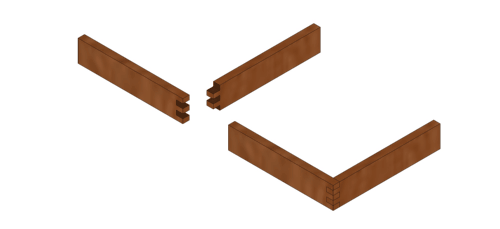 |
|
|
|
Butt or Edge-Glued Joinery - This is the most basic of joinery, whereby one part of a board is glued and/or fastened to another, either end to end, end to edge, end to face, edge to edge (as shown), for example. Generally considered a weak joint if only glued (except for edge-glued panels). Many table tops are made by glueing together several boards and clamping them in place until the glue sets. This works best if the grain direction of the boards are alternating and the boards are clamped in multiple planes to keep the entire panel flat.
|
|
|
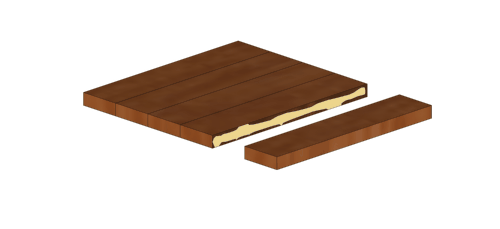 |
|
|
|
Dovetail Joinery - Gets its name from the look of the individual components. Mating project parts essentially interlock and hold tight, which is why it is most commonly used to assemble drawers. There are several variations, including through dovetail (shown), blind dovetail, and half-blind dovetail. Jigs are available now for routers that make it easier to cut matching dovetail components for mating parts. Hand-cut dovetails are considered one of the highest points of craftmanship in making furniture.
|
|
|
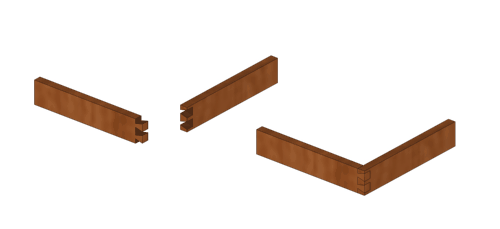 |
|
|
|
Lap Joinery - This method of joinery involves removing a certain amount of the thickness of project parts so that the mating areas overlap one another, hence the name. The cut areas create more surface area to which glue can be applied. Generally, half of the thickness of the designated area of the boards is removed so that when joined, the parts are of matching thickness. A table saw, circular saw, or even router can be used to create these cuts. There are several variations, including end lap (shown), T-lap, and cross lap.
|
|
|
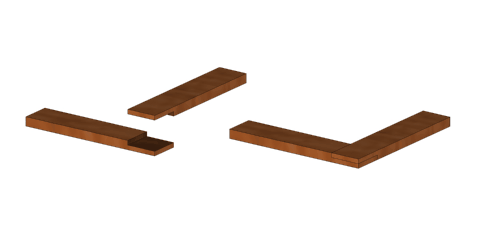 |
|
|
|
Mortise & Tenon Joinery - This method of joinery is essential the creation of a tab on one part and a corresponding slot on the mating part. It is generally considered the strongest method of joinery and is used extensively in fine furniture making. Tenons can be cut using power tools, such as a table saw, or by handsaw. Tenons are made up of cheeks (the part that is cut, both on the edge and face) and shoulders (the uncut area the is adjacent to the cheeks). Mortises are cut using specialized machinery that act as both a drill and a chisel, or with a router. Several variations are used, including blind mortise and tenon (shown), through, stub, and open. Through mortise and tenon joinery is often used in the Arts & Crafts style.
|
|
|
 |
|
|
|
Pocket Hole Joinery - This method of joinery makes use of a screw pilot hole drilled at an angle. Self-tapping screws that drive through wood easily and are specifically designed for this system are driven through the pilot holes of one board and into the mating piece of wood. The concept is essentially the same as toenailing, which is how most homes are framed. It was mainly popularized for creating face frames for cabinetry. It requires a pocket hole jig that clamps a board in place while a stepped drill bit creates the pilot hole.
|
|
|
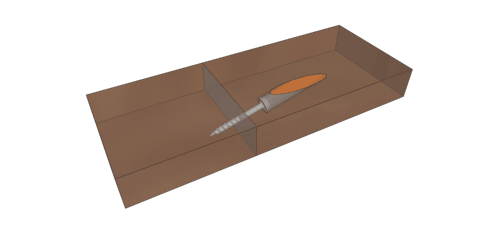 |
|
|
|
Tongue & Groove Joinery - Much like mortise and tenon joinery, tongue and groove joinery consists of a slot (groove) cut on an edge of one board, and a tab (tongue) cut on the edge of the mating board. Good for making panels, this type of joinery can be created using a router bit set specifically designed for this purpose. It can also be created using a table saw with specialty set ups. Bead board paneling made from individual boards use tongue and groove joinery.
|
|
|
 |
|
|
 |
 |
| (C) Chris Hill/Chief’s Shop 2009-2014 |
|
|
|
|